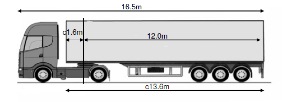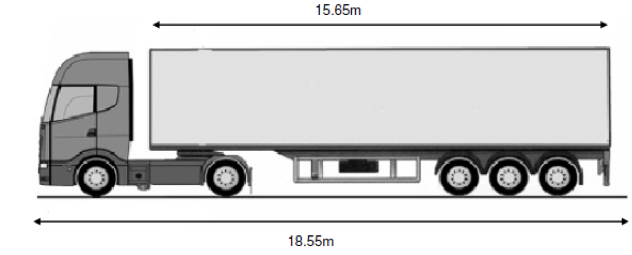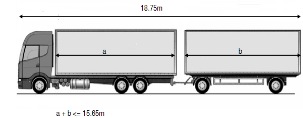Plans to allow the length of articulated lorries to increase by 2.05 metres
Articulated lorries in the UK are currently limited to 16.5m in length. Current plans will extend this to 18.55m (a 12% increase), with an aim to increase road freight capacity.1 Longer vehicles are currently allowed as standard rigid trucks in drawbar trailer combination. (see pictures below)
Heavy good vehicles (HGVs) account for 5-6% of UK traffic 2 but 19% of road deaths. In urban areas they are involved in an even higher number of road deaths, yet make up just 2% of urban traffic 3, 4. All sectors of the population are exposed to road risk however there is evidence the young and those from more deprived backgrounds are at greater risk 5.

Figure 1: Existing standard articulated lorry: overall length 16.5m

Figure 2: Proposed high-volume articulated lorry: overall length 18.55m

Figure 3: Existing standard rigid truck / drawbar trailer combination allowed on UK roads: overall length 18.75m
Evidence of benefits
It is claimed that increasing the capacity of lorries will reduce the overall vehicle numbers, which will in turn reduce road collisions and other wider health effects, including noise and air pollution, obesogenic behaviour and greenhouse gas emissions. However, evidence for this is sparse. The only UK study showed both positive and negative effects. Whilst there were benefits seen to the road sector, it identified potential adverse environmental effects, for example, through shifting transport from rail to road, and increasing investments in parking facilities9.
No European countries have introduced a comparable change in a context relevant to the UK 6. Two major European trials do have some relevance however. The first, based in Germany, showed no adverse affects for the safety of other road users 6. The second, based in Italy, is currently incomplete 6 and may not be generalisable to the UK situation due to haulage regulation differences 7.
One potential wider benefit of larger lorries is reduced carbon emissions. This however relies on reduced numbers of vehicles on roads. The Freight on Rail partnership claim 1 in 4 lorries are already empty, although evidence to back this up could not be sourced.
Evidence of risks
The main health concerns relate to increased deaths and serious injuries in urban environments. The link with vehicle length has not been demonstrated with lorries however t is known that ‘bendy buses’ introduced to the streets of London lead to higher pedestrian and cyclist injuries than their smaller predecessors. A study analysing 15 years of London police data found HGVs were involved in 43% of cyclist deaths 4 but did not consider length of vehicle independently.
One significant problem with many health impact assessments of road traffic is they focus only on Road Traffic Collisions (RTCs) and don’t include other health interactions such as emissions, noise and effects on urban health behaviours 8, 9,10,11,12,13.
Summary & Implications for health & well-being
There is not currently enough evidence to confidently predict how proposed changes to lorry length will affect health. The mechanism for proposed benefits (reduced vehicle numbers) is plausible. However evidence that increased vehicle capacity will lead to this outcome is mixed. Evidence on health risks from longer vehicles is also uncertain with most evidence coming from buses. Finally, many of the health impacts of road traffic tend just to include KSI and do not include wider and likely more significant, but harder to quantify impacts on health and social behaviours.
Author: Stephen Dorey, Specialty Registrar Public Health, LKSS Deanery.
UK area affected: England, Scotland & Wales
1. Department for Transport. Consultation on the possibility of allowing an increase in the length of articulated lorries. Updated 2011 Mar; Cited 2011 Apr 4. Available from: http://www.dft.gov.uk/consultations/open/2011-06/)
2. Department for transport. The latest information on road traffic and speeds. Department for transport UK. Cited 2011 Apr 4. Available from: www.dft.gov.uk/pgr/statistics/datatablespublications/roads/traffic,
3. Morgan AS, Dale HB, Lee WE, Edwards PJ. Deaths of cyclists in London: trends from 1992 to 2006; BMC Public Health 2010, 10:699doi:10.1186/1471-2458-10-699
4. Gilbert K, McCarthy M. Deaths of cyclists in London 1985-92: the hazards of road traffic, 1994 BMJ 308 : 1534; 1994
5. Edwards P, Roberts I, Green J, Lutchmun S. Deaths from injury in children and employment status in family: analysis of trends in class specific death rates. BMJ. 2006 July 7 333 : 119
6. Department for Transport. Longer Semi-trailer Feasibility Study and Impact Assessment, Final Summary Report, Updated 2010 Dec; Cited 2011 Apr 4. Available from: http://www.dft.gov.uk/pgr/freight/research/longersemitrailer/
7. Knight I, Newton W, Mc Kinnon A. Longer and/or Longer and Heavier Goods Vehicles (LHVs) – a Study of the Likely Effects if Permitted in the UK. Published Project Report. TRL Transport and Heriot-Watt University. Available from: http://www.nomegatrucks.eu/deu/service/download/trl-study.pdf
8. World Health Organisation. Promoting physical activity and active living in urban environments – The role of local governments. 2006.
9. Ewing R, Schmid T, Killingsworth R, Zlot A, Raudenbus S. Relationship between urban sprawl and physical activity, obesity, and morbidity, American Journal of Health Promotion. 2003. 18(1), 47-57.
10. Giles-Corti B, Macintyre S, Clarkson JP, Pikora T, Donovan RJ. Environmental and lifestyle factors associated with overweight and obesity in Perth, Australia, American Journal of Health Promotion. 2003, 18(1), pp. 93-102.
11. Heath GW, Brownson RC, Kruger J, Miles R, Powell KE, Ramsey LT. The effectiveness of urban design and land use and transport policies and practices to increase physical activity: A systematic review, Journal of Physical Activity and Health, 3, Suppl 1, S55-S76. 2006
12. Wen LM, Orr N, Millet C, Rissel C. Driving to work and overweight and obesity: findings from the 2003 New South Wales Health Survey. Australia International Journal of Obesity. 2006 30(5): 782-786.
13. Davis A, Valsecchi C, Fergusson M. Institute for European Environmental Policy. Unfit for purpose: How car use fuels climate change and obesity. 2007 August.

Leave a Reply